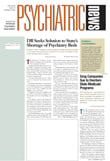APA’s Task Force on Patient Safety held an invitational conference in July to develop a framework for steps the Association can take to help reduce preventable adverse events in psychiatric care and sustain a useful leadership role in specific areas of patient safety. The task force is formulating its final recommendations from the conference and will present them to the Assembly and the Board of Trustees by the end of the year.
“The whole idea of the task force was that we really felt we shouldn’t try to take on the whole ‘world hunger’ of patient safety,” Al Herzog, M.D., vice president of medical affairs at Hartford Hospital, told Psychiatric News. Herzog, a former speaker of the APA Assembly, co-chaired the task force along with Miles Shore, M.D., the Bullard Professor of Psychiatry at Harvard Medical School and scholar in residence at the John F. Kennedy School of Government at Harvard.
“Patient safety is such an important topic,” Herzog added. “So we decided early in the year to focus on three domains, the first being medication errors, the second being inpatient or essential suicides, and the final one being restraints,” he explained.
The task force was set up by the Council on Quality Improvement and has worked closely with APA staff in the Office of Quality Improvement and Psychiatric Services. The task force sought to achieve an improvement in patient safety and a reduction in preventable adverse events within the three domains through closely modeling the recommendations of the 1999 Institute of Medicine (IOM) report, “To Err Is Human: Building a Safer Health System.”
In a one-day workshop in September 1999, the IOM addressed the ways that professional societies could improve patient safety. That meeting identified four areas in which associations could “create a culture of safety.” The four areas are (1) setting standards of practice; (2) convening and collaborating among society members and with other groups; (3) encouraging research, training and education opportunities; and (4) advocating for change.
APA’s practice guidelines address the standards of practice in the diagnostic areas with which they deal. To address the second area identified in the IOM report, the invitation-only conference in July brought together people with strong experience or interest in the three domains, as well as experts in the area of patient safety. Attendees represented many health care professionals, including nonpsychiatric physicians, nurses, administrators, and pharmacists, as well as representatives from other associations and patient-safety advocacy organizations.
“In each of those areas we had excellent speakers, and I would say from the response we had [from invited speakers], people were really willing to come and talk with us, even though we didn’t spend a lot of money,” Herzog said, noting that APA paid only speakers’ expenses. “They said that this is such an important topic that they wanted to come and help us get this done.”
The recommendations from the meeting will address the third and fourth areas identified as roles of associations in the IOM report.
Herzog said the three domains chosen are ones that need obvious attention, but are also ones that task force members believed could be reasonably addressed through solid recommendations.
“The medication errors we are all aware of, and [psychiatrists] are no different from the rest of the medical field in the way we write,” Herzog told Psychiatric News. “With inpatient or essential suicides, we’re seeing the highest incidence among any of the sentinel events that [the Joint Commission on the Accreditation of Healthcare Organizations] monitors—clearly one per week—and not just inpatient psychiatric settings; some happen on medical and surgical floors as well. That’s an important item to note.”
The questions and controversies surrounding the use of seclusion and restraint are well known, Herzog added.
In addressing recommendations to the Assembly and Board, Herzog said, the task force wants to be very thoughtful, seeking as much input as possible. He hoped to talk with more members at APA’s fall component meetings and at the Assembly meeting in the November.
“People need to know what we are doing,” Herzog emphasized, “so that we can seek further input and really make this a collaborative process.” ▪
